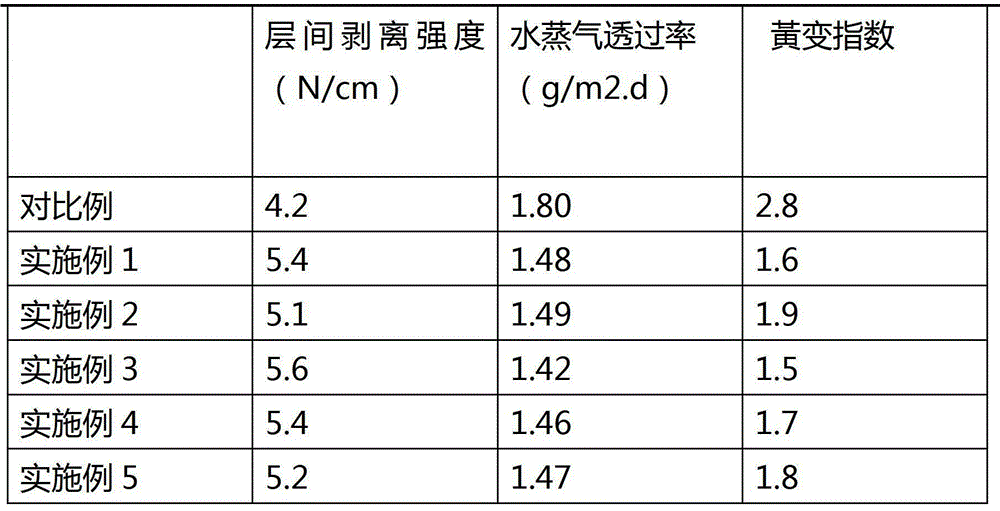A kind of back film of solar battery panel and production process thereof
A technology for solar cells and sheet back films, applied in circuits, photovoltaic power generation, electrical components, etc., can solve the problems of complex process, incompatibility of air permeability and tear strength, etc., and achieve strong interlayer bonding force and good weather resistance. Effect
- Summary
- Abstract
- Description
- Claims
- Application Information
AI Technical Summary
Problems solved by technology
Method used
Image
Examples
Embodiment 1
[0041] Treat the surface of the PET film with a thickness of 150 μm with a surfactant, then wash it with deionized water to remove the oil on the surface of the film, and dry it for later use.
[0042] The PET slices are precipitated after being dissolved in phenol-carbon tetrachloride, and the precipitate is crushed in a pulverizer to powdery PET with a particle size of less than 25 microns.
[0043] In this embodiment, the fluorine-containing resin is polyvinyl fluoride; the solvent is propylene glycol methyl ether; and the crosslinking agent is γ-butyrolactone.
[0044] Mix fluorine-containing resin, PET powder, solvent, crosslinking agent, titanium dioxide (TiO2) and ethylene glycol in a weight ratio of 49:10:10:6:20:5, and mix them uniformly in a glass bead sand mill, Sand mill for 0.5 hours to form a mixed solution with good leveling, fineness less than 25 microns, and moderate viscosity, then heat to 180 degrees Celsius, and apply a layer of fluorine on the adhesive-treat...
Embodiment 2
[0049] The fluorine-containing resin in this embodiment is polyvinylidene fluoride. The solvent is propylene glycol methyl ether; the crosslinking agent is urea-formaldehyde resin.
[0050] Mix fluorine-containing resin, PET powder, solvent, crosslinking agent, silicon dioxide and ethylene glycol in a weight ratio of 50:8:10:6:18:8, mix them uniformly in a glass bead sand mill, and sand After 1 hour, a mixed solution with good leveling, fineness less than 25 microns and moderate viscosity is formed, then heated to 80 degrees Celsius, and a layer of PVDF coating is applied on a clean PET film (thickness is about 150 μm) by roller coating. Floor. After baking at a temperature of 180 degrees Celsius for 15 minutes, the solvent in the PVDF coating volatilizes to form a PVDF film with a thickness of about 20 μm.
Embodiment 3
[0052] The fluorine-containing resin in this embodiment is polytetrafluoroethylene. The solvent is methylpyrrolidone; the crosslinking agent is polyisocyanate.
[0053] The surface of PET film with a thickness of 120 μm is destaticized by corona method,
[0054] Fluorine-containing resin, PET powder, solvent, crosslinking agent, silicon dioxide and ethylene glycol are blended in a weight ratio of 30:10:20:6:30:4, mixed uniformly in a glass bead sand mill, and sanded for 1 Hours, form a mixed solution with good leveling, fineness less than 25 microns, and moderate viscosity, then heat to 180 degrees Celsius, and use a roller coating method to coat a PET film (thickness is about 124 μm) coated with EVA glue. Layer PTFE coating. After baking at a temperature of 150 degrees Celsius for 10 minutes, the solvent in the PTFE coating evaporates to form a film with a thickness of about 20 μm.
PUM
| Property | Measurement | Unit |
|---|---|---|
| thickness | aaaaa | aaaaa |
| particle diameter | aaaaa | aaaaa |
| thickness | aaaaa | aaaaa |
Abstract
Description
Claims
Application Information
 Login to View More
Login to View More - R&D
- Intellectual Property
- Life Sciences
- Materials
- Tech Scout
- Unparalleled Data Quality
- Higher Quality Content
- 60% Fewer Hallucinations
Browse by: Latest US Patents, China's latest patents, Technical Efficacy Thesaurus, Application Domain, Technology Topic, Popular Technical Reports.
© 2025 PatSnap. All rights reserved.Legal|Privacy policy|Modern Slavery Act Transparency Statement|Sitemap|About US| Contact US: help@patsnap.com

